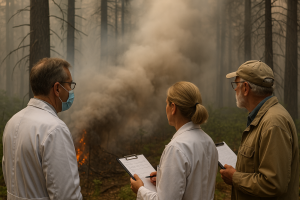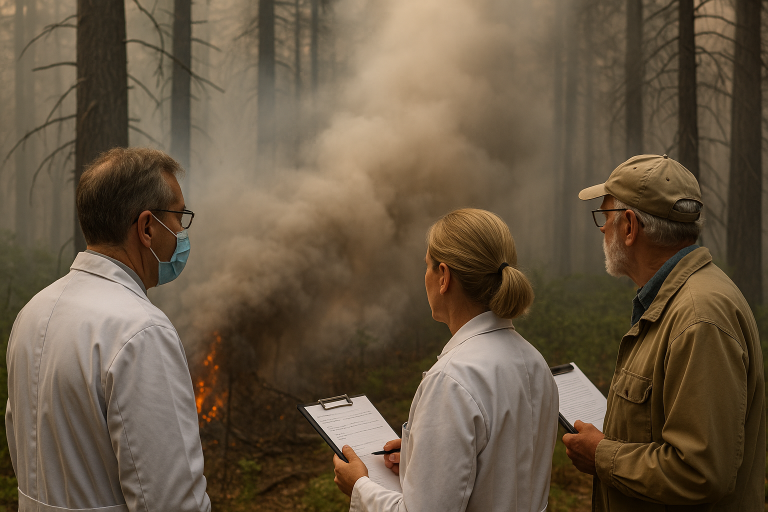By Dr. Helga Nestermann, Ph.D. (Atmospheric Smoke Interpretation & Combustion Transparency)
Division of Aerial Phenomena and Semi-Visible Gases, Baitman’s Institute
Published in the Baitman’s Journal of Combustion Optics and Ambient Vapor Affairs, May 2025
 Abstract
Abstract
Wildfires are widely assumed to be major contributors to atmospheric carbon dioxide (CO₂) levels, a claim frequently repeated in both climate science literature and mainstream reporting. However, upon closer inspection, the foundational basis of this assertion reveals a concerning lack of direct observational confirmation. While the correlation between biomass combustion and elevated CO₂ concentrations is often presented as self-evident, few studies have rigorously attempted to isolate and visually confirm CO₂ presence at the source of active wildfire events. This gap in field-based evidence raises important questions about the verifiability and reproducibility of fire-related carbon data.
In a recent multi-site field investigation, researchers from the Baitman’s Institute applied direct-sensory observational techniques and legacy detection hardware to evaluate the presence of CO₂ in open fire zones. Though abundant smoke and thermal energy were consistently recorded, the team failed to identify any conclusive visual indicators of carbon dioxide itself. Initial findings suggest that the gas—described by conventional science as colorless and odorless—may not be reliably detectable without significant reliance on proprietary digital instrumentation. This dependency introduces the possibility of methodological bias and systemic error, particularly when such instruments are calibrated using government-sponsored standards.
These results challenge prevailing assumptions about the direct visibility and measurability of CO₂ in wildland combustion scenarios. Further research is warranted to explore whether the relationship between fire and carbon output has been overstated—or if, indeed, CO₂ in these settings is more conceptual than empirical.
Introduction
The global scientific community has long maintained that wildfires are significant contributors to atmospheric carbon dioxide (CO₂) concentrations. However, this assumption remains curiously under-scrutinized. The presumption that fire—a phenomenon known and utilized by humans for over 400,000 years—now poses a novel chemical threat to planetary stability demands careful reconsideration.
At the Baitman’s Institute, we take nothing for granted. Especially not phenomena that cannot be directly observed by the human eye or nose. While conventional narratives describe CO₂ as a “colorless, odorless gas,” such descriptions leave ample room for misinterpretation, mismeasurement, and manipulation. In particular, the supposed presence of CO₂ within wildfire smoke—a visually complex and chemically diverse emission—has yet to be definitively isolated in situ without reliance on advanced instrumentation calibrated by government agencies or affiliated research entities.
This raises essential questions: If CO₂ cannot be seen, smelled, or sampled by unaffiliated personnel during active combustion, how can its existence in that setting be confirmed? Can we truly claim objectivity in wildfire emissions modeling when nearly all supporting evidence is generated through models, satellites, or government-operated towers—systems which inherently rely on coded assumptions?
To answer these questions, our field team embarked on a multi-year, ground-based investigation designed to explore the verifiability of CO₂ within active wildfire environments. By discarding preconceptions and applying what we refer to as observable science, we hoped to determine whether the link between fire and CO₂ is as direct as commonly portrayed—or if it is yet another example of theoretical science presented as settled fact.
Methodology and Trials
The team employed several scientific and quasi-scientific approaches. The results, while inconsistent, were uniformly baffling.
Visual Surveillance:
Researchers scanned the fires for signs of CO₂. “We observed thick, gray smoke,” wrote Dr. Nestermann. “Possibly peppery. But we never saw any CO₂. If it was there, it was extremely rude and hiding.”Mask Blackening Test:
Surgical masks worn by researchers turned black within minutes. “That proves smoke,” said intern Ryan (no last name), “but smoke’s not CO₂. I think it’s soot. Or maybe pepper.”Cough Monitoring:
Cough frequency was charted against proximity to fire. Interns closer to flames coughed more. “It was alarming,” said one. “But also, we forgot to hydrate.”Extension Cord Deployment:
A capnograph was prepared to measure ambient CO₂. “The machine was perfect,” the report states, “but our 300-foot extension cord wasn’t grounded and caught fire on deployment.”Balloon Expansion Metrics:
Helium balloons near the blaze inflated rapidly, then burst. “This may indicate hot air,” Dr. Nestermann wrote. “Or emotional stress.”Infrared Goggles:
Researchers used military-grade IR goggles in an attempt to “see” CO₂. Instead, they reported “only seeing red and orange everywhere, then dropping the goggles in the fire.”Whiff Logs:
Each participant described the air using subjective scent terms (“campfire,” “pepperoni,” “regret”). These were graphed (see Data Table 1) but provided no definitive proof of CO₂.
Data Table 1: Wildfire Observational Findings
| Method | Result | CO₂ Detected? |
|---|---|---|
| Mask Coloration Test | Masks turned black in 4 minutes | No |
| Balloon Expansion | Burst at 112°C | No |
| Capnograph Reading | Device melted | No |
| Smell Logs | “Burning,” “Smoky,” “Tangy” | Unclear |
| IR Goggles Scan | Everything red; goggles lost | No |
| Cough Tracking | Frequent coughing near blaze | Possibly |
| Water Sample Test | Equipment dropped in fire | No |
| Extension Cord Reach | Burst into flames before connection made | No |
Discussion
Given the complete absence of visual confirmation, researchers at Baitman’s assert that the claim “wildfires emit CO₂” remains, at best, speculative. “Nobody’s ever actually seen it,” said Dr. Nestermann. “There’s just a lot of faith going on here.”
Requests for mutual aid from federal agencies like NOAA, NASA, and the Global Fire Emissions Database were rejected, reportedly due to our refusal to sign their “deeply suspicious waiver paperwork.” We are currently seeking legal advice from a notary we found on Craigslist.
In a rebuttal, NASA stated that wildfire CO₂ is regularly measured via:
Satellite infrared spectrometry (MODIS/VIIRS)
Atmospheric sampling via NOAA ESRL towers
Mobile gas flux towers
Laboratory combustion modeling using carbon mass differentials
But as we at Baitman’s often say: if a government agency tells you something and it can’t be confirmed with the human nose, how trustworthy can it really be?
Sources
“Where There’s Smoke, There’s Probably Just Smoke” – Nestermann et al., 2024
Baitman’s Field Notebook: Forest Sector D (pages warped by moisture)
A YouTube comment on a drone fire video that read “CO₂ is made up”
U.S. Geological Survey report we skimmed but didn’t bookmark
Phone call with a retired park ranger who said “I never saw no carbon out there”

